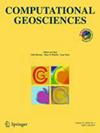Impact of artificial topological changes on flow and transport through fractured media due to mesh resolution
IF 2.1
3区 地球科学
Q3 COMPUTER SCIENCE, INTERDISCIPLINARY APPLICATIONS
引用次数: 0
Abstract
Abstract We performed a set of numerical simulations to characterize the interplay of fracture network topology, upscaling, and mesh refinement on flow and transport properties in fractured porous media. We generated a set of generic three-dimensional discrete fracture networks at various densities, where the radii of the fractures were sampled from a truncated power-law distribution, and whose parameters were loosely based on field site characterizations. We also considered five network densities, which were defined using a dimensionless version of density based on percolation theory. Once the networks were generated, we upscaled them into a single continuum model using the upscaled discrete fracture matrix model presented by Sweeney et al. (2019). We considered steady, isothermal pressure-driven flow through each domain and then simulated conservative, decaying, and adsorbing tracers using a pulse injection into the domain. For each simulation, we calculated the effective permeability and solute breakthrough curves as quantities of interest to compare between network realizations. We found that selecting a mesh resolution such that the global topology of the upscaled mesh matches the fracture network is essential. If the upscaled mesh has a connected pathway of fracture (higher permeability) cells but the fracture network does not, then the estimates for effective permeability and solute breakthrough will be incorrect. False connections cannot be eliminated entirely, but they can be managed by choosing appropriate mesh resolution and refinement for a given network. Adopting octree meshing to obtain sufficient levels of refinement leads to fewer computational cells (up to a 90% reduction in overall cell count) when compared to using a uniform resolution grid and can result in a more accurate continuum representation of the true fracture network.由于网格分辨率,人工拓扑变化对裂缝介质中流动和输运的影响
我们进行了一组数值模拟,以表征裂缝网络拓扑结构、升级和网格细化对裂缝多孔介质中流动和输运特性的相互作用。我们生成了一组不同密度的通用三维离散裂缝网络,其中裂缝半径从截断的幂律分布中采样,其参数大致基于现场特征。我们还考虑了五种网络密度,它们使用基于渗透理论的无量纲密度来定义。一旦网络生成,我们使用Sweeney等人(2019)提出的升级离散裂缝矩阵模型将其升级为单个连续体模型。我们考虑通过每个区域的稳定等温压力驱动流,然后使用脉冲注入模拟保守,衰变和吸附示踪剂。对于每个模拟,我们计算了有效渗透率和溶质突破曲线,作为比较网络实现的兴趣量。我们发现,选择一个网格分辨率,使升级网格的整体拓扑结构与裂缝网络相匹配是必不可少的。如果升级网格具有裂缝(高渗透率)细胞的连通路径,而裂缝网络没有,则有效渗透率和溶质突破的估计将是不正确的。错误连接不能完全消除,但可以通过为给定网络选择适当的网格分辨率和细化来管理。与使用统一分辨率网格相比,采用八叉树网格来获得足够的精细化水平,可以减少计算单元数(总单元数减少90%),并且可以更准确地连续表示真实的裂缝网络。
本文章由计算机程序翻译,如有差异,请以英文原文为准。
求助全文
约1分钟内获得全文
求助全文
来源期刊

Computational Geosciences
地学-地球科学综合
CiteScore
6.10
自引率
4.00%
发文量
63
审稿时长
6-12 weeks
期刊介绍:
Computational Geosciences publishes high quality papers on mathematical modeling, simulation, numerical analysis, and other computational aspects of the geosciences. In particular the journal is focused on advanced numerical methods for the simulation of subsurface flow and transport, and associated aspects such as discretization, gridding, upscaling, optimization, data assimilation, uncertainty assessment, and high performance parallel and grid computing.
Papers treating similar topics but with applications to other fields in the geosciences, such as geomechanics, geophysics, oceanography, or meteorology, will also be considered.
The journal provides a platform for interaction and multidisciplinary collaboration among diverse scientific groups, from both academia and industry, which share an interest in developing mathematical models and efficient algorithms for solving them, such as mathematicians, engineers, chemists, physicists, and geoscientists.
 求助内容:
求助内容: 应助结果提醒方式:
应助结果提醒方式:


